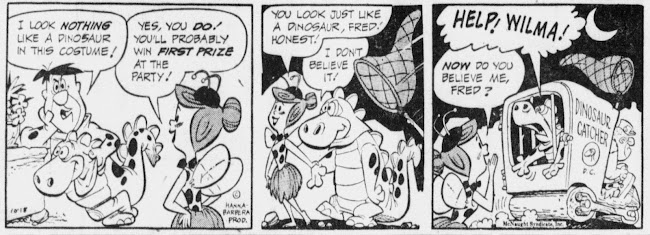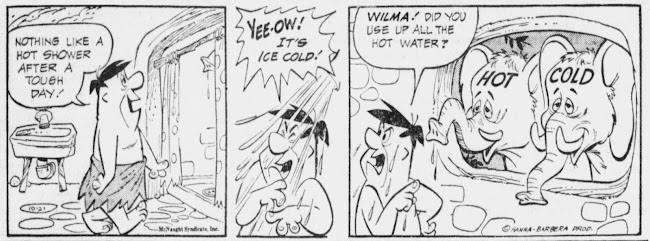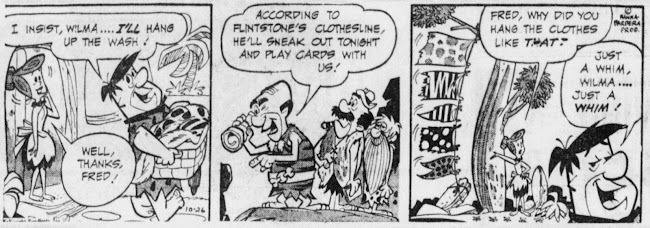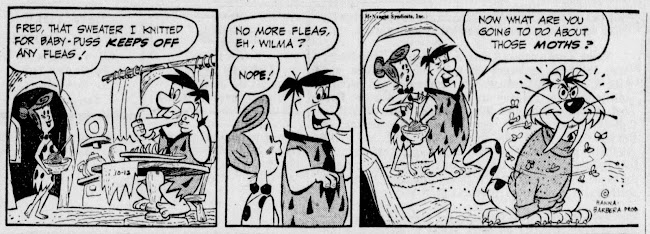It’s pretty simple. I have to know about it. I did not know Mr. De Lyon, nor am I connected with his performers union. He has been out of mind for many people for at least half a century. 50 years ago he was directing an 18-piece orchestra behind the vocal stylings of Sandler and Young. That’s not exactly national television exposure.
As a side note, I remind everyone this blog is, for all intents and purposes, finished. I’ve moved on. I don’t come here now. There are still some finished and half-finished draught posts in my folder than I may get around to putting up (the Tralfaz blog is on auto-pilot until the end of September, though I have banked a number of obits that can be posted).
Anyway, Mr. De Lyon’s union (SAG-AFTRA) reported he passed away last September 18th.
About the only thing most people know about him is he was on Top Cat. I doubt anyone reading here saw him as a regular panelist with Bob Haymes and Dorothy Loudon on “It’s a Business” on the DuMont network starting in March 1952. Or his appearance on Uncle Miltie’s show in 1949 (Dorothy Kilgallen quoted Mr. Berle as saying De Lyon was “a one-man Marx Brothers”). He seems to have spent the bulk of the 1950s in clubs, and made a few talk show appearances in the 1960s.
De Lyon was a case of “fastest rising young comedian.” We find him in June 1948 as part of Paul Whiteman’s stage show in Philadelphia. He was working nightclubs in New York City in less than a year after stops in Toronto, Baltimore and Miami (the last city was likely used to break in his New York act). One of the Philadelphia papers revealed when he was a sailor (submarine service) during the war—and he had to be in his teens then—he stopped in at the Embassy and Little Johnnie’s in Phillie and entertained customers with sketches, impressions and piano playing.
The best profile I’ve found about him is at the start of his career. The New York Daily News published this story on May 15, 1949:
Leo’s Lurid Noises At Last Appreciated
“My getting hooted out of all the basketball games at high school was the cause of it all,” recalls Leo De Lyon, zany young comedian currently featured in the Roxy stage revue. His hop from the Strand to the Roxy, with less than 21 days elapsing in between, chalked up a new mark for the Broadway history hooks. This 23 year old Brooklyn madcap has been tagged “the year’s comedy find” by such theatrical cognoscenti as Arthur Godfrey and Paul Whiteman.
Only six years ago, Leo was a student at Franklin K. Lane High in Dodger-town and was prohibited by the principal from attending any interscholastic basketball game. De Lyon used to hide himself in various shadowed corners of the balcony, wait for exciting portions of the game, and then imitate a referee’s blasting whistle so perfectly, the players on court would halt in their tracks to see who fouled whom. All this just for laughs, and they came in torrents, until Leo was discovered, escorted to the principal’s office and told to stay away front any future basketball contests. So Leo, who shined shoes and sold newspapers after school to increase his meagre allowance, decided he’d eventually try getting paid for his talent at rib-tickling.
Has Huge Range.
De Lyon has a vocal range of 86 notes, all in perfect pitch, which is just two less than the number of ivory-encased do-re-mis on your parlor Steinway, something no Metopera diva can equal. When he toured honky-tonk clubs and resorts in the borscht belt hinterlands late last year, before hitting Broadway, the band musician would tune up their instruments to his voice, tossing aside the accustomed method of using a piano.
 The Catskill paths led Leo to his first major break. He was called upon to join Paul Whiteman’s “On Stage America” unit for one week in Philadelphia, although not for the job he thought.
The Catskill paths led Leo to his first major break. He was called upon to join Paul Whiteman’s “On Stage America” unit for one week in Philadelphia, although not for the job he thought.Whiteman needed a substitute pianist and Leo had mastered the art of 88 back in his school days. During one performance, the maestro suddenly realized his show was running short and looked around for a fill-in. When one of his musicians mentioned pianist De Lyon was adept at zany comedy, thanks to Leo’s impromptu pranks back stage, Whiteman grabbed Leo away from the keyboard and told him to “get out there and do anything you want for about five minutes.”
The results were tremendous. Leo tore down the house with his spontaneous bits of trick voice and song, which encouraged the Brooklyn madcap to seek Broadway stage work.
His next stop was Arthur Godfrey’s “Talent Scouts” radio program. It was only a few months ago that Leo appeared on the Godfrey show and won hands down. His mother was so overjoyed she led a parade of some 50-odd De lyon rooters from Brownsville down Broadway with a “the treat’s on me” call. Was Leo’s victory toasted in the chi-chi confines of the Stork or El Morocco? Certainly not. His mother took the neighborhood fan club to a cafeteria on 50th St. and treated one and all to coffee and Danish.
In 1950, De Lyon was performing overseas. One show was at London’s venerable Palladium. In the middle of the decade, he toured Australia with Johnny Ray. At the end of the decade, he was performing at Danish Days in Cedar Falls, Iowa. In January 1961, he emceed at the Minneapolis Auto Show before moving across the U.S. from New York to Los Angeles to try to further his career. By early May, after an appearance at the National Orange Show, he had been cast in Top Cat (along with Michael O’Shea, who was un-cast as T.C. fairly quickly).
After Top Cat failed to catch on in prime time, Leo headed back onto the road for more fairground-type m.c. But Hanna-Barbera wasn’t through with him. Here he is from the soundtrack of the 1966 feature A Man Called Flintstone.
He also contributed incidental voices to The Smurfs.
With his versatile vocal chords (his club act once featured him singing as both Jeanette MacDonald and Nelson Eddy), he was a natural for novelty records, a huge industry in the ‘50s and ‘60s. This was the debut single for Musicor Records, according to writer Al Kooper. The backup band was the Aristocats, a group from Kooper’s home town. The song was copyright August 23, 1960.
In 2020, Leo and his wife moved into a home in Ventura, California. At age 95, the graduate of Julliard tickled the ivories and someone recorded a snippet of him. You can find it on Facebook.
Fans of Top Cat likely know he was interviewed for the DVD set dealing with the series. Over the years, people have posted parts of these great extras on YouTube only to have them taken down. With some trepidation, I link to Mr. De Lyon below and hope it’ll remain.
Someone reading here will wonder who is still around from the early Hanna-Barbera days. Working back from Top Cat, the voice of Yakky Doodle, Jimmy Weldon, will be 99 later this year. I have not been able to determine if the original voice of Blabber Mouse, former KFWB disc jockey Elliot Field, is still enjoying life in the Palm Desert area. He would be turning 95 this year.
Perhaps the most appropriate of the many gigs Mr. De Lyon played was in 1969. He headlined the programme at the all-county meeting of the Westchester Lighthouse at a church in White Plains, New York. The guest speaker at the event was a woman named Mrs. Dibble.





























